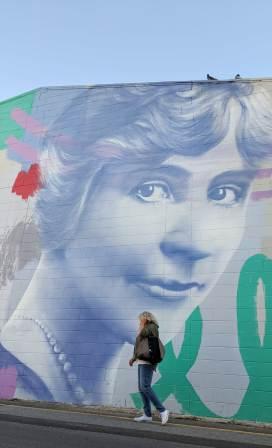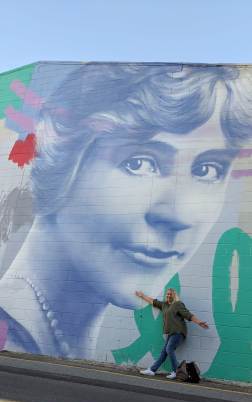
I’m stuck for new superlatives every time I find these street murals that take your breath away in their scale and perfection. Another example I found recently, is this mural by Claire Foxton which can be found in Dawkins Place in the east end of Adelaide.
It inspired me to want to find out more about the woman who is the subject of the artwork. Her name is Muriel Matters and her story is as follows:
The Subject
Muriel Matters was an Adelaide born suffragist who not only fought for the rights of women, but advocated for the poor, the uneducated and animal rights.
She was born in the suburb of Bowden in 1877 and her family valued education including high school where at the annual prize giving ceremony she would sing, play the piano and perform elocution. In the city of Adelaide the women’s movement was just beginning to gain traction. Women who owned property were already allowed to vote at local government level and in 1894 the South Australian Legislative Assembly voted in favour of women aged 21 and over, the right to vote and to stand for election. Members of Muriel’s family were heavily involved in social issues at the time which would have influenced her greatly. As part of her upbringing she had private lessons in public speaking and was one of the first female students to take to the stage as a speaker.

She was too young to vote in South Australia’s 1896 election but she was able to vote seven years later when women were permitted to vote in a Federal election for the first time.
At the age of 20 she moved to Sydney to pursue her stage career which she did successfully. After a few years though in which she is said to have found stage life for women repugnant, she returned to Adelaide and resumed work teaching elocution. She had a romantic relationship with a man by the name of Bryceson Treharne, a musician and newspaper columnist, but it didn’t last because of their differing opinions on equality for women. Muriel instead began taking an interest in fundraisers for nurses and the blind and gave speeches on curriculum at the Teachers Association.
At 28 she moved to the UK to pursue her dream of being an actress where she achieved success but also continued teaching elocution and performing in private homes to supplement her earnings.
In the UK she became disillusioned with the treatment of young actresses and female stage crews and she organized the ‘League of Light’ to support vulnerable young women of the stage and studios.
By the age of 29 she was observing the rise of the women’s suffrage movement in the UK and began adding her voice to the campaign. She made her first speech for the Women’s Freedom League in 1907, speaking of the effects of the Women’s Vote in Australia.
Muriel rose to prominence in the movement leading marches and making speeches in the suffragette’s campaigns including a 3 month ‘Votes for Women’ caravan tour of the UK with another veteran campaigner. The gypsy like horse drawn wagon was emblazoned with slogans, and toured from town to town to gather more supporters. For her part, Muriel would speak of the Australian experience and the impact that suffrage had on social and economic improvements for the good of women and the whole nation.
In 1908 she infamously chained herself to the grille of the Ladies Gallery in the British House of Commons, using the iron gate as a symbol of the women being separated from taking part in parliamentary debate. For this she served a month’s imprisonment for willfully obstructing London Police.
It didn’t deter her efforts though, when in 1909 she took to the air in an airship, for the world’s first airborne protest, dropping ‘Votes for Women’ leaflets as King Edward VII was being transported in his carriage to open the new session of parliament. The airship was adorned with the slogan Votes for Women in lettering large enough to be seen from the ground and trailed streamers in the Women’s Freedom League colours of white, gold and green.
In 1910 she returned to Australia to run a series of lectures across the country where she was known as ‘That daring Australian girl’ and ‘The Lady of the Grille’.
When she returned to London she turned her efforts to helping those in need and in 1914 married Dr William Arnold Porter and became Muriel Matters-Porter. They never had children and she lived in Hastings until her death on 17 November 1969, aged 92.
The Artist
Claire Foxton is an Australian artist from Wollongong NSW and her murals are distinctive in style and recognizable by their mix of abstract and realistic techniques. She paints photo realistic portraits and her subjects are often strong local characters that spark interest and encourage us to investigate the people and their stories more deeply.
This mural of Muriel Matters was painted as part of the Adelaide Fringe Festival in January 2018.

The Muriel Matters Award
By delving deeper into this fascinating woman’s life I have also discovered that just this year the Muriel Matters Awards were instituted by the Minister for Education and the Speaker of the South Australian Parliament House of Assembly.
These awards have been established to recognise young people in SA secondary schools from years 7 to 12, who meet a number of criteria including showing self-initiative and commitment to making a difference in the community.
The awards recognise the work and life of Muriel Matters and the difference she made through her work and activism, to further the rights and freedoms of women and promote universal access to education.

To learn more about the wonderful Miss Muriel Matters, you can read her life story which was written in 2017 by Robert Wainwright.
Cheers
Glenys

What a wonderful post Glenys and an incredibly inspiring woman.
LikeLiked by 1 person
Wasn’t she fabulous! I’m so glad I went off on a tangent and found out about her. 😀
LikeLike
What a woman of conviction she was. Great post.
LikeLiked by 1 person
Thank you, I love finding people’s stories. So many fascinating Aussies that are largely unknown today. The blurb on the book about her says, ‘Discover the most inspiring woman you’ve never heard of’, how true!
LikeLike
Tracking down these stories makes the journey much more interesting doesn’t it.
LikeLiked by 1 person
Absolutely 🙂
LikeLiked by 1 person
Muriel is an Australian to be proud of.
LikeLiked by 1 person
Yes indeed!
LikeLike
What a wonderful way to acknowledge and celebrate Muriel and her dedication and commitment to her passions and beliefs. She paved the way for the rest of us.
LikeLiked by 1 person
Yes I’m glad I have found out about her now, and won’t forget her name and what she achieved.
LikeLiked by 1 person
The mural of Muriel Matters matters! Fascinating story! Thanks for having the interest to research the wall art and share it here. What a rebel for her time … even for today it’s pretty extreme, although perhaps more common, to chain yourself to a gate!
LikeLiked by 1 person
Thank you, I had to follow through and find her story and so glad I did. What a woman!
LikeLiked by 1 person